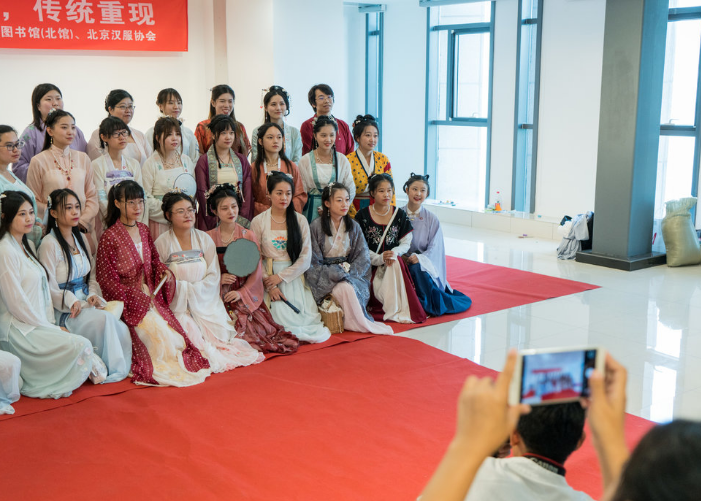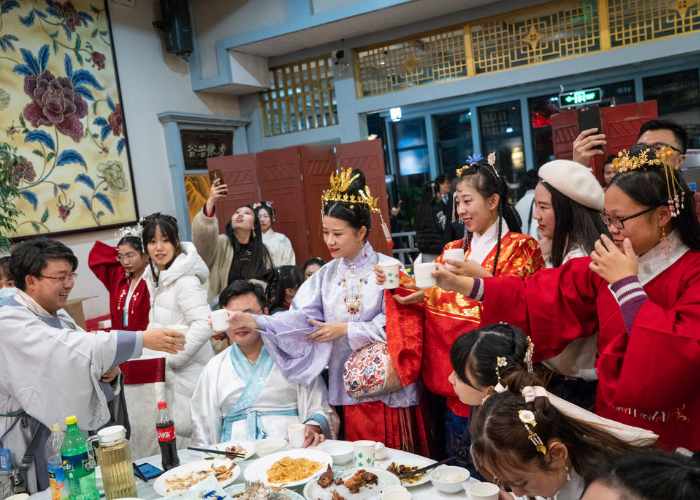Hanfu is suitable for traditional festivals, ceremonies, modern social events, and daily wear.
Historical and Cultural Significance of Hanfu
Hanfu, the traditional dress of the Han Chinese, embodies a profound historical and cultural legacy. This attire represents more than fashion; it’s a vivid expression of the aesthetic and philosophical values deeply rooted in ancient China.
Origins and Evolution of Hanfu
The Hanfu story begins in the Han Dynasty (206 BC – 220 AD), marking a journey through China’s rich history. Initially, the attire featured loose robes, wide sleeves, and a cinching waist belt – each element a reflection of social status and ethical values. As time progressed, Hanfu evolved, mirroring the societal changes in China. The Tang Dynasty (618–907 AD), for example, brought more elaborate Hanfu styles with vibrant colors and intricate patterns, echoing the era’s prosperity and openness. This evolution isn’t just a change in fashion; it symbolizes the dynamic nature of Chinese culture.
The modern revival of Hanfu isn’t just a fashion trend; it’s a cultural renaissance. The Hanfu movement sees the youth reconnecting with their heritage, using traditional attire as a form of cultural expression. This resurgence is a global phenomenon, showcasing the universal appeal of Chinese culture.

Symbolic Meanings in Hanfu Designs
Every aspect of Hanfu bears deep symbolic meaning. The designs, colors, and patterns, far from being mere decorative elements, carry significant cultural connotations. Dragons and phoenixes in Hanfu embroidery, for instance, symbolize auspiciousness and nobility. The color red in Hanfu stands for good fortune and joy, while green signifies growth and harmony. These details reflect the Confucian ideal of harmony and order.
The structure of Hanfu itself is a cultural statement. The cross-collar design, tying to the right, represents respect for nature, echoing ancient Chinese philosophy. Each fold and layer in Hanfu speaks to the Chinese values of balance and symmetry, rooted in Taoist and Confucian principles.
Hanfu links the past with the present, serving as a vivid representation of China’s rich history and a living tradition that evolves continuously. Its popularity among the younger generation is more than a fashion statement; it’s a bridge to their cultural roots, fostering a deeper understanding and appreciation of their heritage. The resurgence of Hanfu is a testament to its timeless appeal and its role as a symbol of cultural identity and pride.
The elaborate patterns, vibrant colors, and symbolic motifs of Hanfu narrate the rich tapestry of Chinese history and culture. Hanfu is more than a traditional garment; it’s a cultural icon, encapsulating the essence of Chinese civilization in its folds.
Traditional Festivals and Ceremonies
Hanfu, as a traditional Chinese attire, plays a significant role in various festivals and ceremonies, encapsulating the essence of Chinese culture and traditions.
Chinese New Year and Hanfu
Chinese New Year, also known as the Spring Festival, stands as the most celebrated event in Chinese culture. During this festival, Hanfu becomes more than just attire; it becomes a symbol of renewal and cultural pride. Families often choose Hanfu with bright colors, particularly red, to reflect the joy and good fortune associated with the New Year. Children, adorned in miniature Hanfu outfits, add vibrancy to the celebrations. The intricate designs of Hanfu during this period often feature motifs like dragons, phoenixes, and flowers, each symbolizing prosperity, longevity, and renewal.
Wearing Hanfu during the Spring Festival has seen a resurgence in recent years, especially among the youth. This trend is not just about fashion but a deeper connection with cultural roots. Hanfu in the Chinese New Year is a bridge between generations, allowing the younger ones to embrace and celebrate their heritage in a modern context.
Wedding Ceremonies and Hanfu Attire
In traditional Chinese weddings, Hanfu plays a pivotal role. The bride and groom often wear specially designed Hanfu that symbolizes their union and blessings for the future. The bride’s Hanfu, typically in red, signifies love, joy, and prosperity, while the groom’s attire, often in darker shades, symbolizes stability and strength.
Hanfu in weddings is not just clothing; it’s a ceremonial garb that carries the weight of traditions and blessings. The designs often incorporate elements like the ‘double happiness’ symbol or depictions of mandarin ducks, signifying marital bliss. Modern Chinese weddings witness a blend of traditional and contemporary styles, with many couples opting for Hanfu to pay homage to their cultural heritage.
The Mid-Autumn Festival
The Mid-Autumn Festival, a time for family reunions and moon worship, sees Hanfu as a central element of the celebration. People wear Hanfu to participate in traditional activities like moon viewing, lantern parades, and reciting moon poems. Hanfu during this festival is often lighter and more flowing, reflecting the autumn season’s gentle nature.
The designs on Hanfu for the Mid-Autumn Festival frequently feature moon motifs, rabbits, and other elements associated with lunar mythology. Wearing Hanfu becomes a part of the ritual, connecting people with the ancient traditions of moon worship and appreciation of the autumnal beauty.
In each of these festivals and ceremonies, Hanfu is more than just an element of dress; it’s a vibrant expression of Chinese culture and history. The revival of Hanfu in these traditional settings speaks volumes about the enduring legacy and evolving nature of Chinese cultural practices. It’s not only about preserving the past but also about infusing contemporary relevance into these age-old traditions.
Hanfu in Modern Social Events
Hanfu, once a symbol of ancient Chinese tradition, has found its way into modern social events, creating a unique blend of the past and present. This integration into contemporary life not only preserves the cultural heritage but also enriches modern social practices.
Tea Ceremonies and the Elegance of Hanfu
Tea ceremonies in China are a blend of art, spirituality, and social interaction. Wearing Hanfu during these ceremonies enhances the experience, creating a sense of historical continuity and cultural authenticity. The elegance of Hanfu complements the serene and contemplative nature of tea ceremonies. Participants often wear Hanfu styles that reflect the particular dynasty most associated with the tea culture they are celebrating. For example, a Tang-style Hanfu might be chosen for a ceremony focusing on the high Tang tea culture.
The choice of Hanfu for these ceremonies is meticulous. Light fabrics and subtle colors are preferred to match the tranquility of the tea setting. The flow of the robes and the grace they bring to the wearer’s movements add a visual dimension to the ceremony, making it an immersive cultural experience. Tea ceremonies in Hanfu offer a window into the past, allowing participants to relive a piece of ancient Chinese culture in the modern world.
Hanfu Meet-ups
Hanfu meet-ups have become popular social events, especially among the youth. These gatherings serve as a platform for enthusiasts to celebrate their love for traditional attire and share knowledge about their cultural heritage. Participants at these meet-ups often showcase a variety of Hanfu styles, each telling a different story of Chinese history and fashion.
These meet-ups are not just about displaying traditional clothing; they are interactive cultural events. Workshops on Hanfu history, traditional Chinese crafts, and even ancient Chinese etiquette are common. Hanfu meet-ups are pivotal in reviving and preserving traditional Chinese culture, offering a space for people to connect with their heritage and with each other. They also play a crucial role in educating the younger generation about the importance of their cultural roots.
Art Exhibitions and Cultural Expos Featuring Hanfu
Art exhibitions and cultural expos have begun to feature Hanfu, showcasing it as an art form rather than just a piece of clothing. These events display various Hanfu styles, each representing different historical periods and cultural contexts. Visitors get an opportunity to see the evolution of Hanfu over centuries, understanding its significance in Chinese culture.
These exhibitions often include interactive elements, such as trying on Hanfu or demonstrations of traditional dressing techniques. They serve as educational platforms, providing insights into the craftsmanship behind Hanfu and its role in Chinese art and culture. By featuring Hanfu, these exhibitions and expos not only celebrate traditional Chinese attire but also highlight its relevance in the contemporary cultural dialogue.
In each of these modern social events, Hanfu acts as a bridge between the past and the present. It brings traditional Chinese culture to life, allowing people to experience and engage with their heritage in a dynamic and interactive manner. The resurgence of Hanfu in these settings is a testament to its enduring appeal and its significance as a living cultural symbol.

Hanfu in Daily Life and Education
The resurgence of Hanfu in modern China is not just a nod to tradition but also a vibrant part of contemporary life and education. This traditional attire is making its way into daily life and educational settings, promoting a deeper connection with Chinese heritage.
Incorporating Hanfu into Everyday Wear
Integrating Hanfu into daily attire has become a growing trend among people who wish to express their cultural identity. Modern Hanfu designs are adapting to contemporary lifestyles, making them more practical for everyday use. Designers are blending traditional Hanfu elements with modern fashion, creating outfits that are both culturally significant and comfortable for daily activities.
This fusion of traditional and modern styles has led to an increase in Hanfu’s popularity among all age groups. People are now wearing Hanfu for various activities, from casual outings to formal events. This daily wear Hanfu often features simpler designs and more durable materials, ensuring both elegance and practicality. The adoption of Hanfu in daily life is not just about fashion; it’s about making a personal statement and keeping a cultural legacy alive in everyday settings.
Educational Settings
In educational settings, Hanfu is being introduced as a way to educate students about Chinese culture and history. Some schools and universities are organizing Hanfu days, where students and teachers wear traditional attire. These events serve as interactive learning experiences, allowing students to explore the historical and cultural significance of Hanfu.
Educational institutions are also incorporating lessons about traditional Chinese clothing into their curriculum. Students learn about the evolution of Hanfu, its various styles, and the cultural contexts behind them. This approach not only enriches the students’ understanding of Chinese culture but also fosters a sense of pride and identity.
Promoting Cultural Education through Hanfu
Hanfu is more than attire; it’s a tool for cultural education. Museums, cultural centers, and community organizations are using Hanfu to teach people about Chinese history and traditions. Workshops and exhibitions allow individuals to experience Hanfu first-hand, learning about the fabrics, designs, and the art of dressing.
These educational programs often include hands-on activities, like Hanfu-making workshops, where participants can create their own traditional garments. By engaging in these activities, people gain a deeper appreciation for the craftsmanship and cultural significance of Hanfu. Promoting cultural education through Hanfu not only preserves this traditional attire but also helps in keeping the rich tapestry of Chinese culture vibrant and relevant in today’s world.
Incorporating Hanfu into daily life and education is playing a crucial role in reviving and sustaining Chinese cultural heritage. It allows individuals to connect with their history and traditions in a tangible way, enhancing their understanding and appreciation of their cultural identity. As Hanfu continues to gain popularity, it symbolizes the enduring legacy and evolving nature of Chinese culture in the modern world.